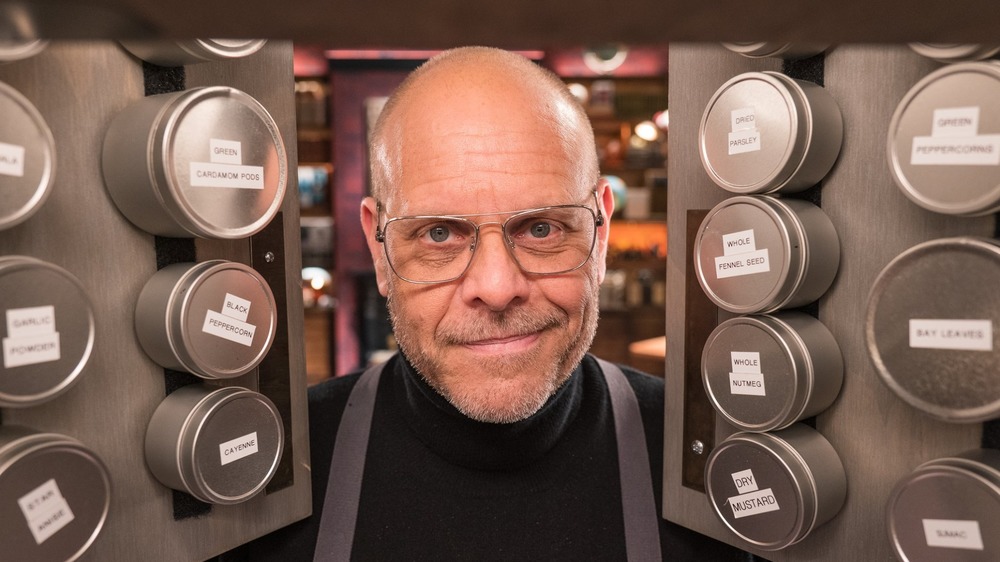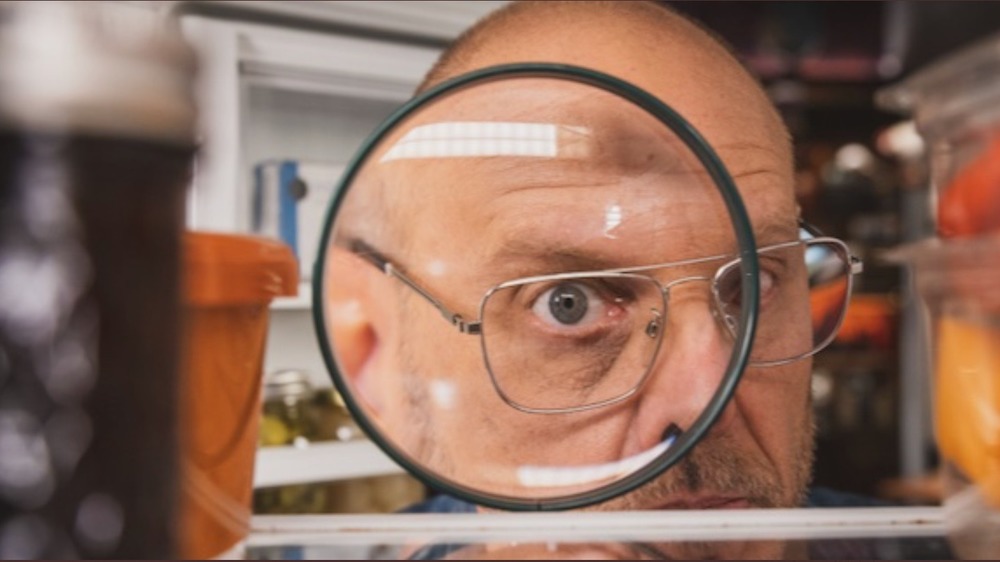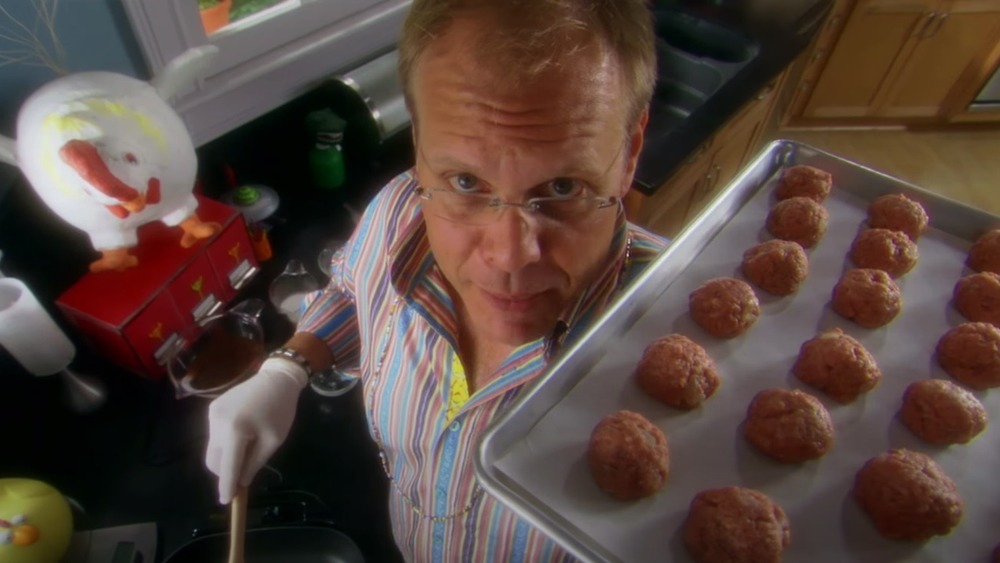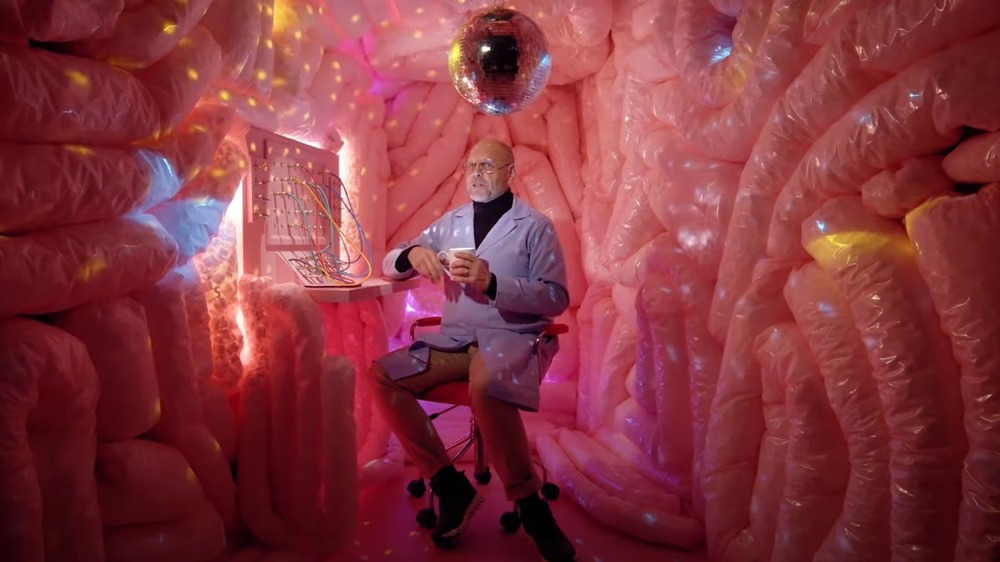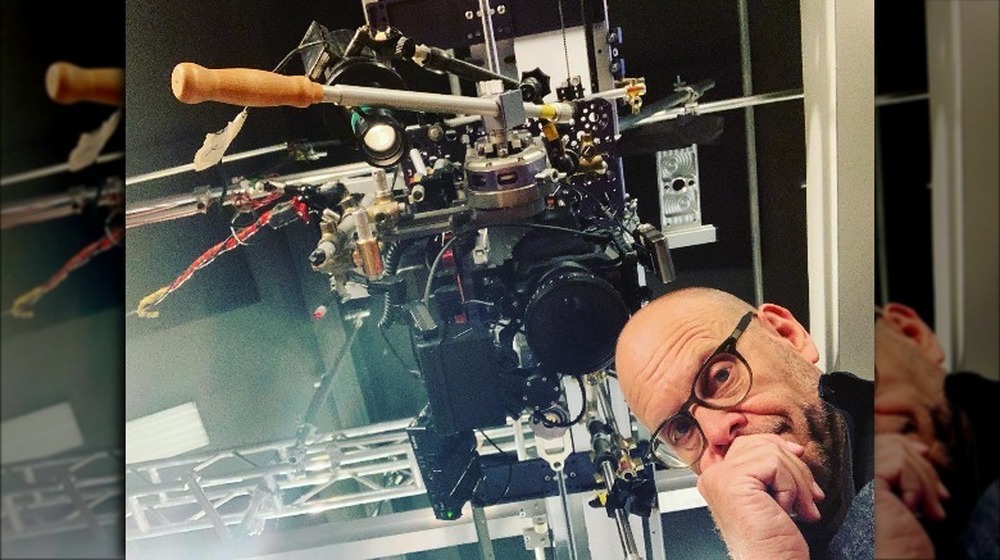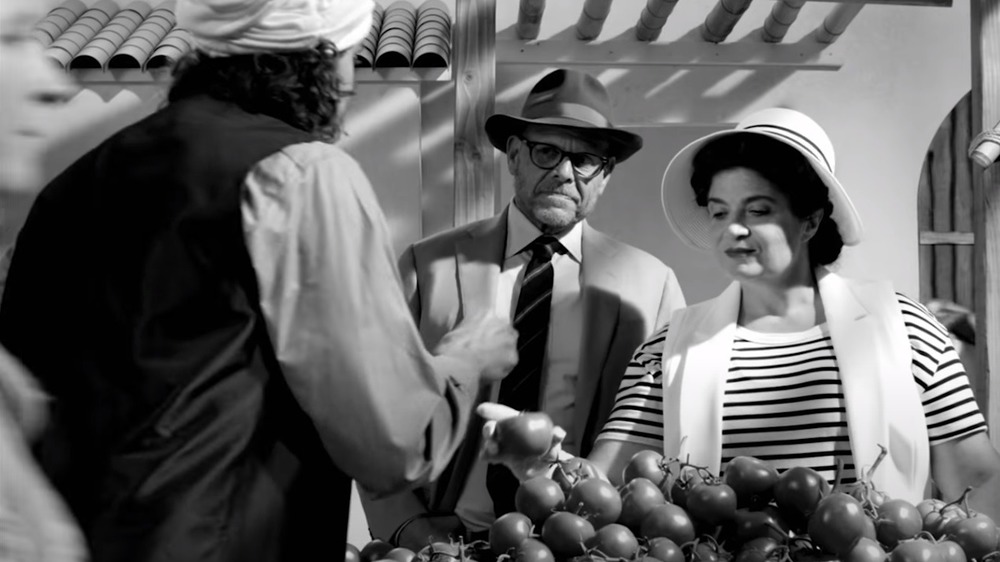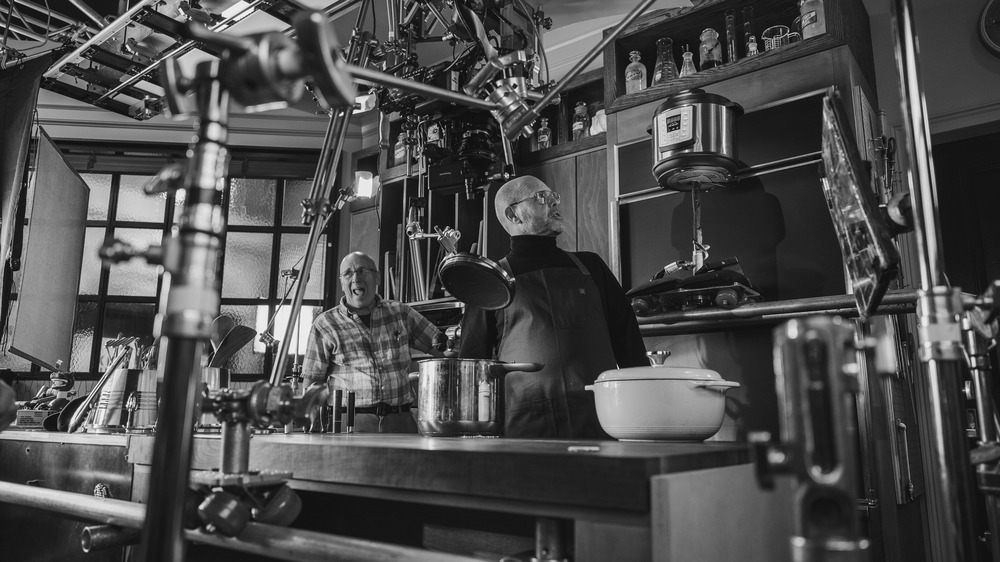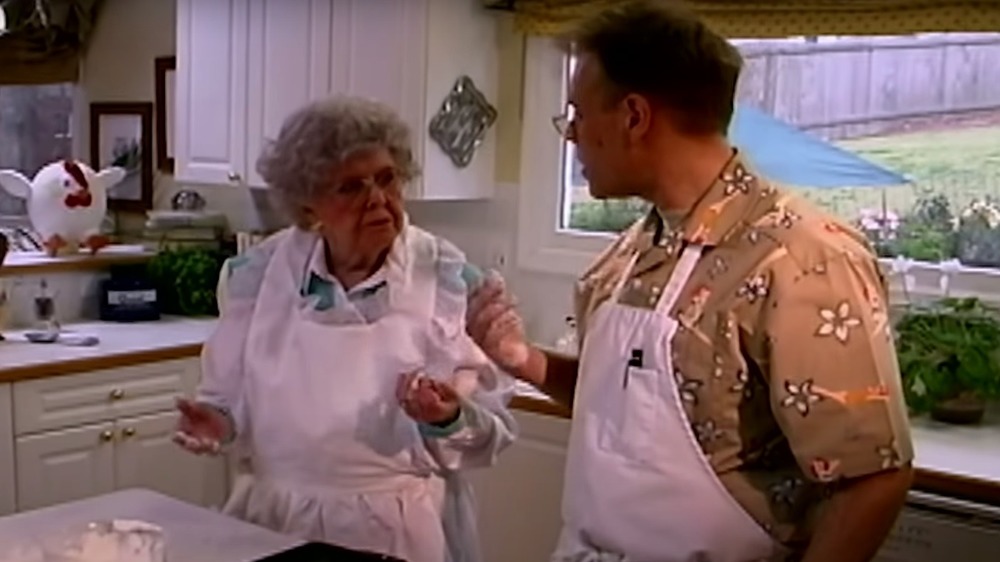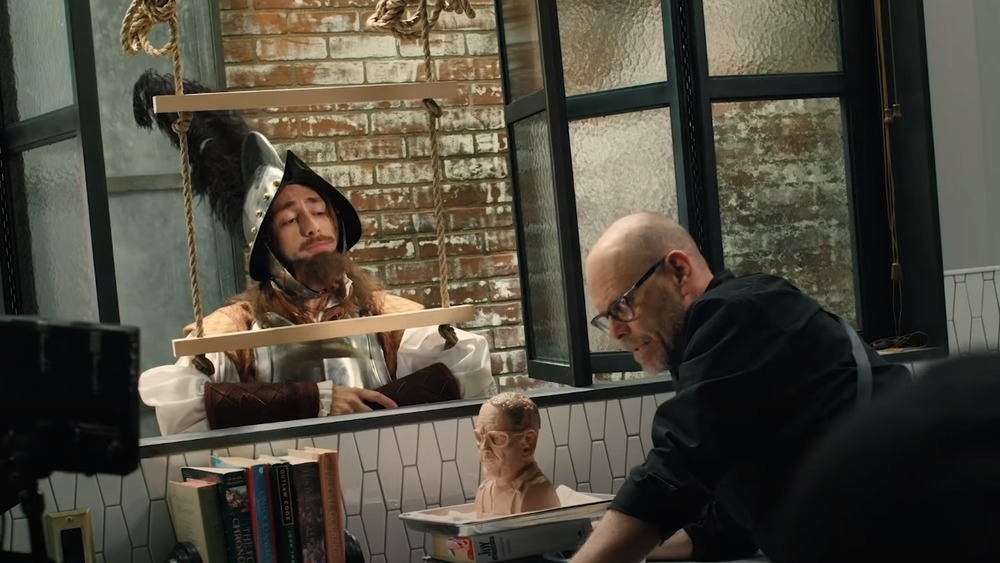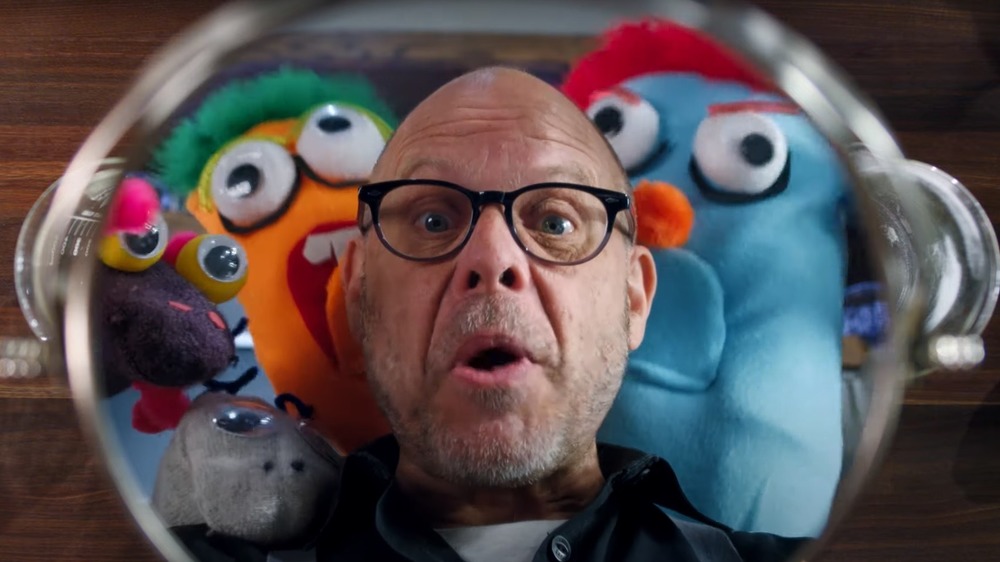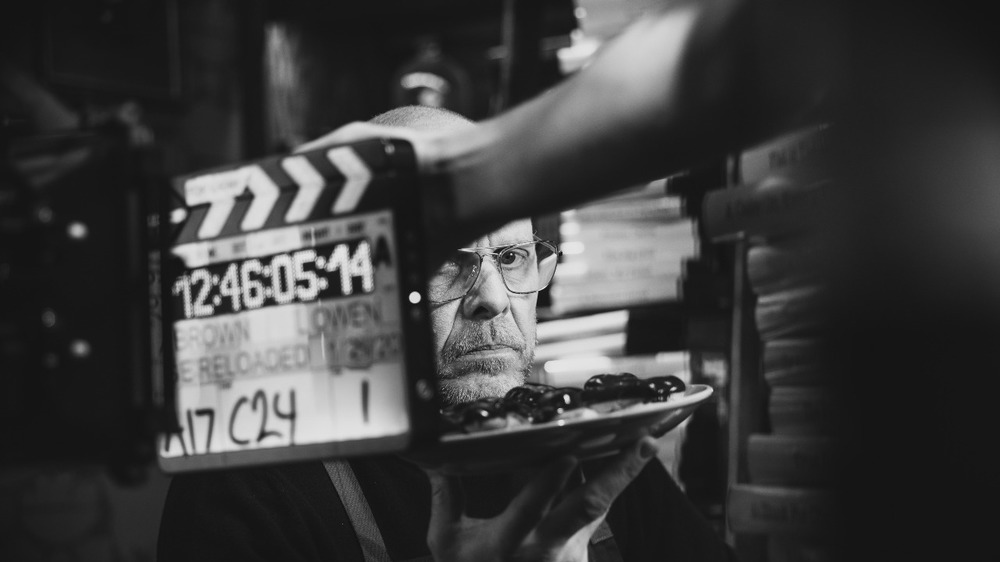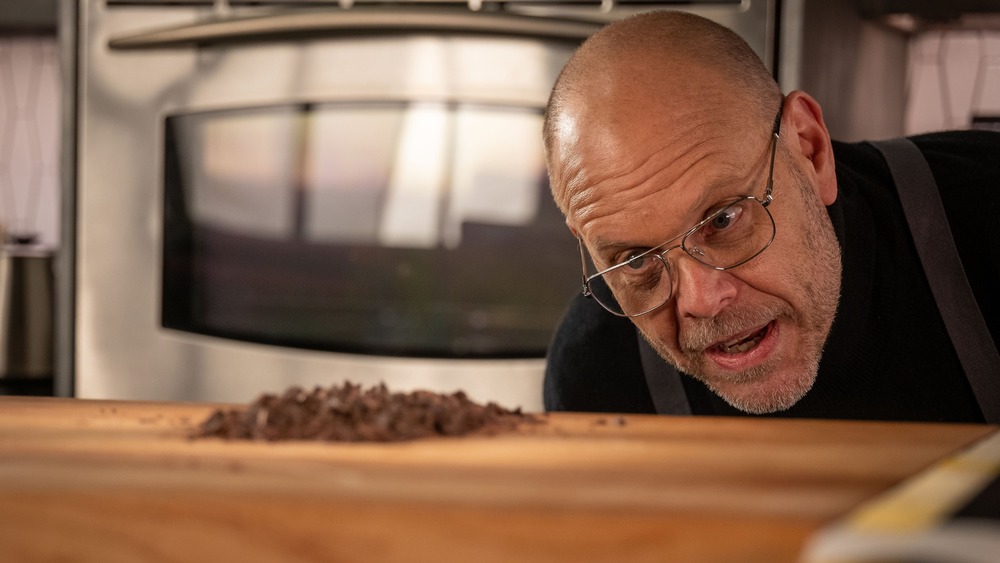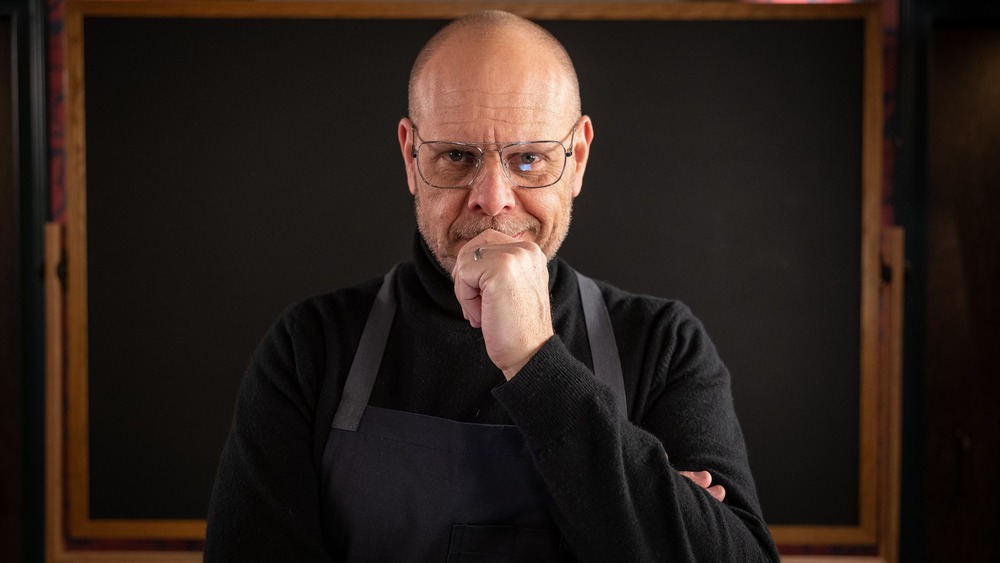The Untold Truth Of Good Eats
It's safe to say that practically anyone with a passing knowledge of cooking television has heard of Good Eats. In fact, it's also likely that you've watched an episode or two, or even become a fan of the series. Good Eats was one of the first shows on Food Network or any other similar channel to both dive into the science of cooking and to do so in a way that was, simply, a lot of fun. Any one episode usually boasts skits, oversized props, and a whole host of puppets in the service of whatever ingredient or dish is featured.
But, for all that's going on in front of the camera, at least as much work has gone on behind the lens to make it all happen. According to an interview with Good Eats showrunner and star Alton Brown on the Good Eats Fan Page, the first pilots for the show were produced in 1997 and aired on Chicago public TV the next year. In 1999, it first aired on the Food Network and ran more or less continuously there for 13 years until Brown put the show into stasis in 2012, according to Fast Company.
Since then, Good Eats has returned in two forms, with Good Eats: Reloaded extensively reworking old episodes and Good Eats: The Return presenting entirely new episodes (via Food & Wine). So, what's gone into the show to make it so beloved? Here's the untold truth of Good Eats, past and present.
Good Eats' Alton Brown was bored by cooking shows, so he created his own
Good Eats has its genesis in the cooking shows of the 1990s, but not in the way you might expect. Alton Brown admits that the staid formats of these shows, which merely showed someone cooking in a generic television kitchen, over and over, were incredibly boring.
In an interview with Bitter Southerner, Brown said that he first started thinking more critically of cooking shows while he was a young film school graduate directing commercials in Atlanta, Georgia: "I was like, 'God, these are boring. I'm not really learning anything.' I got a recipe, OK, but I don't know anything." The shows endemic to food TV at the time merely passed down rote information without explaining the how or why of what was happening. There was, in short, no real craft or curiosity to cooking shows, at least as Brown saw it.
So, with the specter of boring TV hanging over his shoulder, Brown began to develop an idea for a different kind of show. Instead of standing sedately behind a counter, the camera would move around as the host explained the nitty gritty of cooking. As NPR reports, he wrote down three names: famed TV chef Julia Child, along with TV science educator Mr. Wizard, and comedy troupe Monty Python. With those three inspirations in mind, Brown set out to make what would prove to be groundbreaking food television.
Alton Brown originally wasn't going to be the host of Good Eats
Though Alton Brown always planned to be the brains behind Good Eats, he wasn't always going to be the one talking up cookery and science in front of the camera. Someone else was actually supposed to present the ideas. As Brown wrote in Good Eats: The Early Years, said host would have to be equally knowledgeable and "snarky", given the comedic tone of the series. "I was thinking we would probably get someone out of the Actor's Studio or maybe the Royal Academy," Brown joked.
Despite his background in film, Brown was no actor and certainly not a graduate of the Royal Academy of Dramatic Art. So, how did he end up on the other side of the camera? "That was a money thing," he wrote in Good Eats: The Early Years. As the creative process for the show rolled forward, there were simply not enough funds to hire a host. In an interview with the Television Academy Foundation, he also noted that the company that funded Good Eats' two pilot episodes made an offer based on the condition that Brown would host, with another person directing.
Brown was initially reluctant because he had "no experience" performing on film before the day of the first pilot, to the point where he initially walked to the wrong side of the camera the first day on set, forgetting that he was supposed to be in front of the lens.
Good Eats leans hard on the science of cooking
Good Eats was one of the first cooking shows to get down to the nitty-gritty science of cooking. And there was a lot of science to cover. Wired called Brown a "culinary hacker" for his approach to food, which is inherently linked to things like physics and biology. This approach has also meant that some tidbits of cooking wisdom, previously accepted as gospel, were thrown out the window. Just because an idea is old doesn't always mean that it's best, Good Eats argues.
Neither does it really help a cook understand what's going on in the seemingly never ending quest to make really good food. Good Eats argues that people can only cook well once they fully understand the science behind something like meringue, which means diving into the science of proteins and heat transfer.
On both the original run of Good Eats and its recent revival, Brown employs illustrations, charts, props, and more to communicate all of these scientific concepts, a la his inspiration, TV-based science educator Mr. Wizard. It's a little ironic as, according to Forbes and Brown himself, as he barely passed most of his science classes.
Good Eats is deeply linked to Alton Brown's film background
Before he became a television host and chef, Alton Brown had already begun to establish himself in the film industry. According to Biography, Brown studied film through the University of Georgia's theater department. After graduation, he worked filming commercials and music videos, including the video for rock band R.E.M.'s "The One I Love."
Eventually, Brown's interest in food began to take over, meaning that he left the film industry and, with the encouragement of his first wife, attended the New England Culinary Institute in Montpelier, Vermont. Yet, a careful look at Good Eats reveals that Brown never really left the film world.
According to The Daily Meal, the first two pilot episodes of Good Eats were shot on film, as opposed to the then more-common tape. In an interview with the Television Academy Foundation, Brown claimed that this was because he simply didn't know how to handle tape, but it certainly distinguished the pilot. Per The Daily Meal, clips from the two episodes were hosted on the Kodak website, where it caught the eye of a Food Network representative.
Good Eats was also one of the first cooking shows to employ a variety of film effects, including the Dutch angle. According to the Nashville Film Institute, a Dutch angle is a visual effects where the camera is tilted, creating a diagonal perspective. It's traditionally used to provide a sense of disorientation, but it's also sometimes simply a cool visual.
Good Eats is based in pop culture as much as food culture
Though Good Eats is obviously based on previous cooking shows with a healthy hit of science added to the mix, that's not all that went into this groundbreaking series. Remember that Brown's initial list of inspirations included not only Julia Child and Mr. Wizard, but absurdist comedy troupe Monty Python (via NPR). And, much in that same weird, comedic vein, Good Eats has been packed full of pop culture and history references ever since.
Those references run the gamut of practically all modern pop culture, from horror author Stephen King to rock band U2. In an interview with the Good Eats Fan Page, Brown recalled filming one episode that clearly took its cues from King's 1987 novel, Misery. In the episode's narrative, Brown's car breaks down and he is saved by an enthusiastic but ultimately very menacing fan. Another episode, season 12's "Oh My, Meat Pie", riffs on Sweeney Todd while Brown's supposed ancestor shows the audience how to prepare shepherd's pie and mincemeat.
Ultimately, the references became so numerous that they now command their own dedicated page on TV Tropes, which collects the show's references to salsa commercials, Dune, revenge film John Wick, and many, many more.
The Good Eats crew came up with ingenious solutions to get the right shot
The show's crew wasn't above removing the backs of cabinets, fridges, and other appliances to get some of the show's iconic shots. That's still very much in play on Good Eats: The Return, where Brown took viewers on a tour of the revamped kitchen set (via Food Network). "There are a lot more than there used to be," he said, showing a series of back-less appliances such as an oven, a cabinet, a microwave, and a mock refrigerator.
As Brown said in an interview with the Television Academy Foundation, some of his favorite episodes were the ones showing off the team's most technical achievements, especially when it came to getting just the right shot. Good Eats eventually became well known for its use of mirrors and magnifying glasses to provide multiple perspectives for the viewers. Yes, this was done all with practical effects, with nary a touch of CGI. Brown said that these ad-hoc tools were "very intricate assemblages of sliders and mirrors" to accomplish some of the ways the show would subvert the classic (and cliched) "hands and pans" shots that so bored Brown when he watched earlier cooking shows. "You could actually get three different shots within a shot", he said of the crew's innovation.
Alton Brown's family and community appeared on Good Eats
A notable number of guests who appeared in front of the camera on Good Eats included Brown's own family members. As The Daily Meal reports, these included Brown's own daughter and a brief appearance by his mother, though his first wife, DeAnna, declined to appear. His grandmother, "Ma Mae", appeared on the early episode, "And the Dough Also Rises." As Brown wrote after her 2001 death, "She thought my own Frankensteinian desire to understand food was on the silly side," but gamely appeared on the show to demonstrate her masterful biscuit-making skills for all to see (via Good Eats Fan Page).
One of the most notorious and beloved characters on Good Eats was actually drawn from the local community. A chiropractor and actor, Vickie Eng, landed a recurring role as the surly equipment specialist, "W," who holds an especial dislike for Alton Brown. In an interview with the Television Academy Foundation, Brown said that she got the role in part because she showed "an immediate dislike" for him during the audition, making her just right for the prickly character. "You could tell everything I did irritated her," he said. Eng occasionally acted as a chiropractor for some of the other crew members, though Brown says she never worked on him.
Good Eats crew can also double as cast members
Some cameos and recurring roles on Good Eats were played by real-life experts, like actual nutritional anthropologist Deb Duchon. Duchon, who was a professor at Georgia State University, often appeared on the show to deliver scientific information about the topic at hand. As she told the Good Eats Fan Page, "I'm not a character." Still, the production crew did occasionally dress her up quite like the other characters who appeared on the show. She recalled being put into a traditional English riding ensemble for one episode where she appeared on a horse. Given her intense fear of horses, they also had to re-record her audio later.
Yet, the vast majority of the Good Eats cast weren't university professors or relatives of Alton Brown. Instead, it was the crew. "Most of the roles were played by crewmembers," Brown said in an interview with the Television Academy Foundation, stating that it was an informal rule that crew had to make an appearance in front of the camera on occasion. Sometimes, that could be a tad embarrassing, as video editor Brett Soll found out. According to Food Network, Soll, with his intimidating physique, was often cast in roles like those of a Swiss girl, a peasant wife, a miner's wife, and other feminine characters. As a break, Soll was later cast as an elf for an episode on crackers, complete with pointy ears and a black bobbed wig.
Many Good Eats props were made on the fly
Over the course of its run, Good Eats has become both beloved and notorious for its use of props. These aren't any normal props straight out of some bland warehouse, either. Brown has often asked for oversized props to help demonstrate concepts or to just get a good laugh. Per Food Network, production designer Todd Bailey reported that the crew typically made about 20 props every day during the 1999-2012 run of the series. Some of those creations went on set mere minutes after they came into existence. These included a six-foot human nose and a similarly gigantic pomegranate, among many other props.
Yet, not all of the props that have debuted on Good Eats are oversized demonstrations of concepts like the Maillard reaction or what the inside of a corn kernel looks like. In an interview with Baltimore magazine, Brown noted that many episodes feature puppets. And few have stood out more amongst this plethora of puppetry than the yeast sock puppets. They are indeed little more than socks with googly eyes glued to them, continuously burping and otherwise releasing gas much as real-life yeast does on a much smaller scale. Practically everyone, it seems, loves them and the rest of the Good Eats props for the silly humor and improvisational (or, okay, occasionally slapdash) look.
Good Eats ended its original run in 2012
The original run of Good Eats lasted for a frankly astounding 13 years, spanning 14 seasons and a dizzying variety of topics centering on food, science, and comedic riffs. Yet, as much as the show had cemented itself in the Food Network lineup and had garnered a large fanbase, things had to end. As Alton Brown told TODAY, as much as he loved working on the show, it became an obsession that was growing to almost unhealthy levels. "It also nearly killed me," he said. Or, as he told Larry King in somewhat less dramatic fashion, "I got tired."
Disappointed as fans may have been, they were given cause to hope nearly at the same time that Good Eats ended its 14th season. Brown explicitly stated that the show wasn't necessarily gone forever. "I've put 'Good Eats' into cryogenic holding," he said. "I'm not saying it's gone [...] I didn't kill it" (via TODAY). Hopeful as they may have been, however, fans of Good Eats would still have to practice some serious patience while the show was kept in stasis.
Good Eats has returned twice
About six years after the last episode of Good Eats' 14th season aired, viewers were treated to a kind-of reboot in the form of Good Eats: Reloaded. These revamped original episodes first began airing in 2018 on the Cooking Channel, according to TheWrap. They featured Brown revisiting his earlier days on the show, simultaneously critiquing his earlier techniques, offering new and improved advice, and at least once lamenting the demise of his hairline. Good Eats: Reloaded has since aired for two seasons of 13 episodes each.
Yet, Brown wasn't going to extensively tinker with his previous work, as entirely new episodes were coming down the line via Good Eats: The Return. This reboot is an extension of the original show that premiered in 2019, as Delish reports. Brown partially credits the return to the public new awareness of food and greater ingredient accessibility. "Everything has changed as far as availability," he said, which opened up the new version of the series to explore previously unknown ingredients such as the now ultra-popular quinoa or meals like shakshuka. Beginning in February 2021, new episode of Good Eats: The Return began airing on discovery+, the new streaming service launched by television network Discovery (via TheWrap).
The new Good Eats has to be mindful of technological changes
As it turns out, much of the return of Good Eats has hinged on technology. According to TheWrap, Alton Brown wasn't just tired of the amount of work he put into the original show, but he was also waiting for film and cooking technology to catch up to what he and the crew wanted to accomplish. When Good Eats first closed up shop in 2012, Brown says, he was aware that the landscape of television was about to change dramatically, though it wasn't clear how, exactly, such a shift was going to pan out.
As he told Forbes, Brown acknowledges that the way people watch the show and how they approach the subject has become more advanced. He no longer feels as if he has to coax viewers into certain concepts or avoid complicated words. "We've gone full throttle," he said. At the same time, though viewers may be bingeing the new episodes on smartphones, some things have remained old school, like Good Eats' use of analog practical effects. Just like the old show, for example, many of the appliances on the film set are missing backs to accommodate cameras, while careful viewers will note that the mirror assemblies that include both Brown and his cooking surface in one shot are back.
